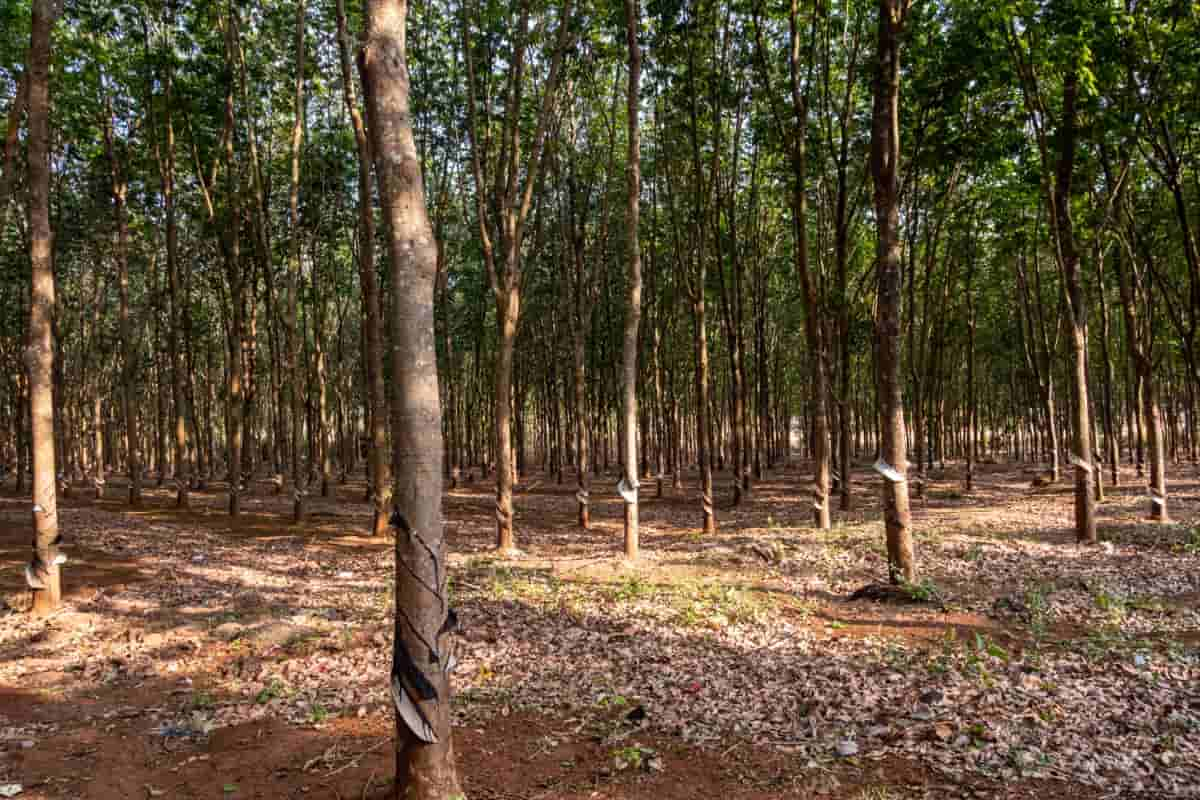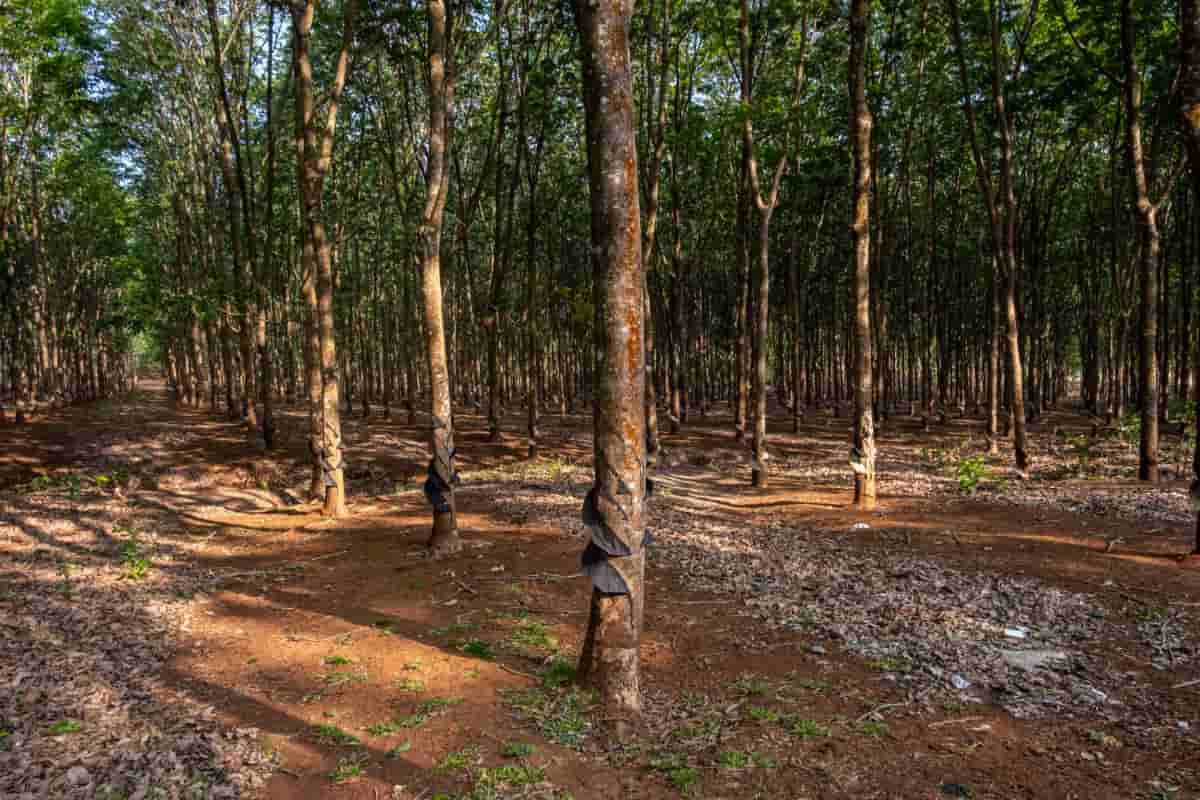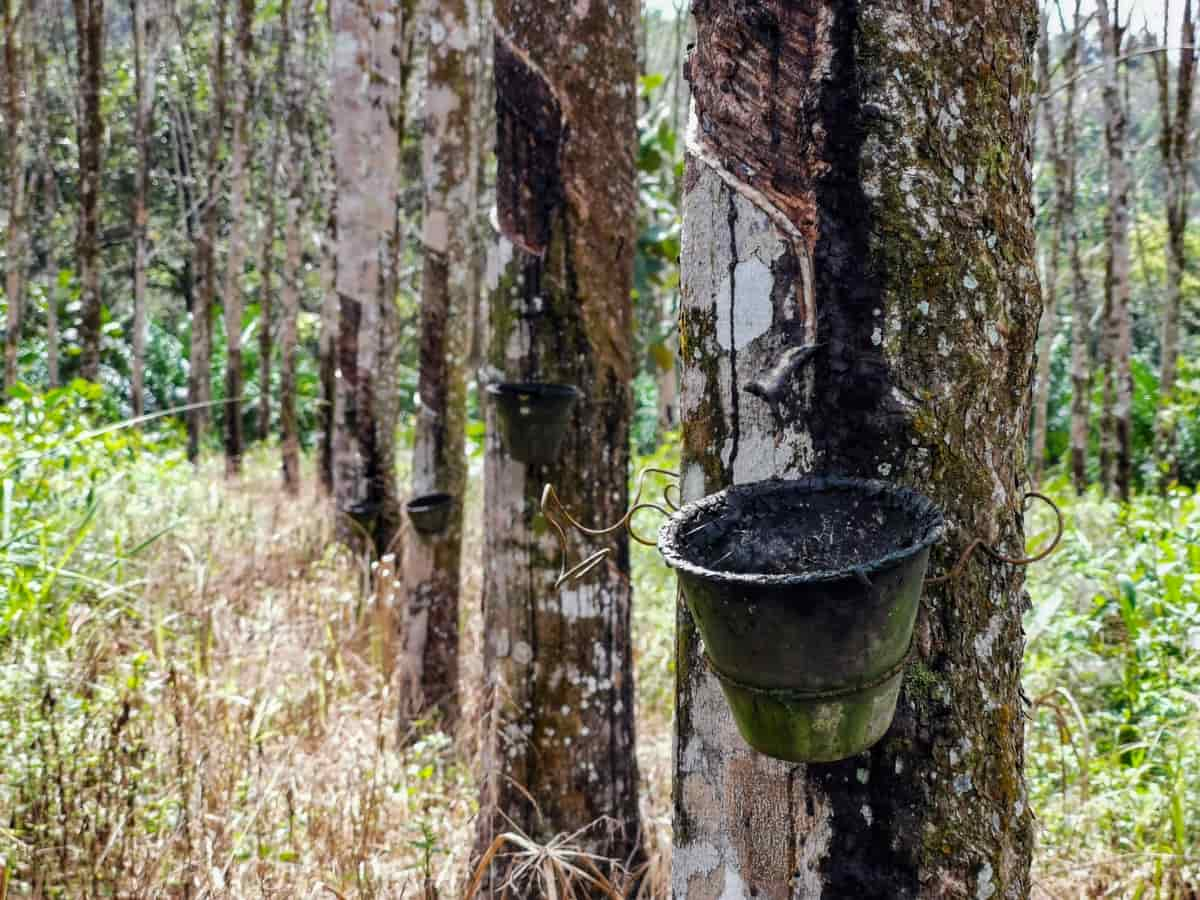Drip irrigation has emerged as a pivotal technology in optimizing water usage and enhancing crop yield in agriculture, and its application extends to rubber plantations. This involves delivering water directly to the plant roots, minimizing wastage, and maximizing efficiency. Rubber cultivation, a vital industry, stands to benefit from the precision of drip irrigation.

The initial investment for drip irrigation in a rubber plantation varies based on factors such as plantation size, topography, and equipment quality. On average, the cost ranges from Rs. 1,50,000 to Rs. 1,80,000 per acre. This includes expenses for drip lines, filters, pumps, valves, and installation. High-quality systems with advanced technology may incur higher costs but offer better efficiency and long-term benefits.
Drip Irrigation Cost for Rubber Plantation
Evaluate the Cost of Drip Lines and Emitters for Rubber Fields
The cost of drip lines and emitters for rubber fields varies based on factors like field size, water requirements, and brand preferences. On average, quality drip lines can range from Rs. 8 to Rs. 15 per meter, while emitters may cost between Rs. 5 to Rs. 10 each. For a standard rubber field, covering an acre may require approximately Rs. 20,000 to Rs. 22,000 for drip lines and emitters. However, consider the long-term benefits of water efficiency and increased yield when evaluating the overall cost-effectiveness of these irrigation systems for rubber cultivation.
Analyze the Expense of Filters and Pressure Regulators in Drip Irrigation Systems
Filters are crucial in preventing clogging of emitters, ensuring efficient water flow, and maintaining system longevity. Pressure regulators help optimize water pressure, enhancing the uniformity of irrigation. Investing in high-quality filters and pressure regulators minimizes maintenance costs and maximizes the effectiveness of water distribution in agriculture, making them essential components for sustainable and cost-effective drip irrigation practices, contributing to overall crop yield improvement.
The expense of filters and pressure regulators in drip irrigation systems typically ranges from Rs. 18,000 to Rs. 20,000 per acre, depending on the specific requirements and quality of components.
Estimate the Cost of Automation and Control Systems in Drip Irrigation for Rubber
The incorporation of automation and control systems in drip irrigation for rubber plantations introduces efficiency and precision in water management. The cost of such systems can vary based on the level of automation and the size of the plantation. On average, the expense for automation components like sensors, controllers, and monitoring devices can range from Rs. 30,000 to Rs. 35,000 per acre.
Advanced systems with features such as real-time data analytics and remote control capabilities may incur higher costs. However, the investment in automation pays off through improved resource utilization, reduced water wastage, and enhanced crop performance.
Assess the Price of Pumps and Pumping Stations for Drip Irrigation in Rubber Farming
The cost of pumps can vary based on factors such as capacity, type, and brand. Generally, centrifugal pumps, commonly used in drip irrigation, can range from Rs. 20,000 to Rs. 22,000 per unit, depending on specifications. Pumping stations, which include additional components like filters, valves, and control systems, can incur additional costs, averaging between Rs. 10,000 and Rs. 13,000 per acre. Farmers must select pumps that align with the water requirements of their rubber plantation and consider the overall system efficiency.
In case you missed it: Drip Irrigation Cost for Tea Plantation: Exploring Installation Costs Along with Subsidy Per Acre

Explore the Cost of Fertilizer and Nutrient Injection Systems
Fertilizer and nutrient injection systems play a crucial role in optimizing crop growth in rubber plantations through drip irrigation. The cost of integrating these systems depends on factors such as the type of fertilizers used, the complexity of the injection setup, and the size of the plantation. The average cost for these systems can range between Rs. 25,000 and Rs. 30,000 per acre.
This includes the expense of purchasing injectors, tanks, and other components necessary for precise and controlled nutrient delivery. The investment in these systems is justified by the improved efficiency in nutrient application, leading to better plant health, increased latex production, and overall yield enhancement.
Calculate the Labor and Installation Costs
Labor and installation costs are significant considerations when implementing drip irrigation in rubber plantations. The complexity of the system, terrain, and size of the plantation influence these expenses. On average, labor and installation costs can range from Rs. 18,000 to Rs. 20,000 per acre. Skilled labor is required for laying drip lines, installing emitters, setting up automation systems, and ensuring proper integration of all components.
The expertise of laborers contributes to the efficient functioning of the drip irrigation system. While these costs are integral to the initial investment, they are often outweighed by the long-term benefits in terms of water efficiency and increased productivity. Farmers need to consider these expenses when budgeting for the adoption of drip irrigation technology in rubber plantations.
Factor the Maintenance and Repair Expenses
Maintenance and repair expenses are ongoing considerations for drip irrigation systems in rubber farming to ensure sustained performance and longevity. The average annual maintenance and repair costs can range from Rs 10,000 to Rs. 15,000 per acre. This includes routine checks, component replacements, and preventive measures to address issues like clogging or system malfunctions.
In case you missed it: Drip Irrigation Cost for Pumpkin: Exploring Installation Costs Along with Subsidy Per Acre

Energy Costs Associated with Drip Irrigation in Rubber Cultivation
The energy costs associated with drip irrigation in rubber cultivation primarily involve the operation of pumps and, in some cases, automation systems. Pumps are essential for transporting water from the source to the plantation through drip lines. The energy requirements depend on the pump’s capacity, efficiency, and the duration of irrigation cycles. Generally, the energy costs for drip irrigation can range from Rs. 10,000 to Rs. 12,000 per acre annually.
Cost Analysis of Drip Irrigation Per Acre for Rubber Plantation
| Item | Cost Range (Rs.) |
| Drip Lines & Emitters | 20,000 to 22,000 |
| Filters and Pressure Regulators | 18,000 to 20,000 |
| Automation and Control Systems | 30,000 to 35,000 |
| Pumps and Pumping Stations | 30,000 to 35,000 |
| Fertilizer and Nutrient Injection Systems | 25,000 to 30,000 |
| Labor and Installation Costs | 18,000 to 20,000 |
| Maintenance and Repair Expenses | 10,000 to 15,000 |
| Energy Costs | 10,000 to 12,000 |
Government Subsidy for Drip Irrigation in Rubber Plantation
Government subsidies for drip irrigation play a crucial role in encouraging farmers to adopt water-efficient and sustainable agricultural practices. Subsidies aim to reduce the financial burden associated with the initial investment in drip irrigation systems. The Indian government has introduced a centrally sponsored scheme on micro irrigation with the objective of enhancing water usage efficiency in the agriculture sector by providing appropriate technological intervention like drip and sprinkler irrigation technologies.
The scheme PMKSY focuses on micro-level storage structures, efficient water conveyance and application, and precision irrigation systems. Under the PDMC (Per Drop More Crop) component of Pradhan Mantri Krishi Sinchayee Yojana (PMKSY), Financial assistance to the farmers will be up to 55% for small & marginal farmers and 45% for other farmers.
Compare the Overall Operational Costs of Drip Irrigation vs. Traditional Methods in Rubber Farming
Traditional methods, such as flood irrigation, often lead to higher water consumption, increased labor requirements, and greater energy usage for water distribution. The costs associated with manual labor, water wastage, and potential environmental impacts make traditional methods less cost-effective in the long run.
In case you missed it: Drip Irrigation Cost for Almond Plantation: Exploring Installation Costs along with Subsidy Per Acre

In contrast, drip irrigation minimizes water wastage by delivering water to the plant roots, reducing the overall water requirement. Despite initial setup costs, drip irrigation systems prove more efficient over time, contributing to lower operational costs. Moreover, the precise control afforded by automation in drip systems leads to optimized resource use and reduced labor requirements.
Conclusion
While the initial investment for drip irrigation may seem substantial, potential subsidies and long-term benefits, such as increased efficiency and sustainability, make drip irrigation an economically and environmentally responsible option for rubber cultivation. Careful consideration of technology, government support, and efficient resource management ensures a balanced and fruitful investment in the future of rubber farming.
- Feed Your Flock for Less: Top 10 Tips to Save on Chicken Feed
- Ultimate Guide to Ossabaw Island Hog: Breeding, Raising, Diet, and Care
- Hatching Answers: The Top 10 Reasons Your Chickens Aren’t Laying Eggs
- Eggs and Economics: Breaking Down the Cost of Raising Backyard Chickens
- Defend Your Greens: Proven Methods to Keep Iguanas Out of Your Garden
- Ultimate Guide to Cinnamon Queen Chicken: A Comprehensive Guide for Beginners
- Ultimate Guide to California Tan Chicken: Breeding, Raising, Diet, Egg-Production and Care
- Ultimate Guide to Marsh Daisy Chicken: Breeding, Raising, Diet, and Care
- 10 Types of Chicken Farming Businesses You Can Start for Profits